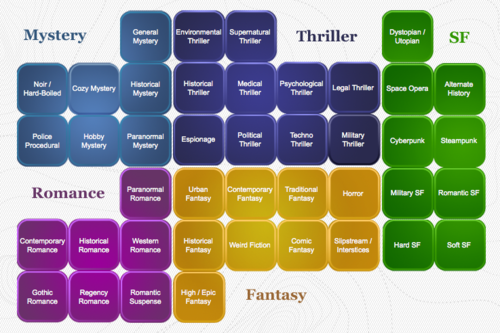I recently suggested that Genre is no more or less complicated than identifying your audience. Put another way, genre is a crude, pre-Internet way of approximating, "customers who liked this also liked these others."
The problem of categorization doesn't go away in the coming e-book utopia where we won't be limited by traditional bookstore shelving constraints. In fact, the always-on world of digital media multiplies the opportunities (or demands) to know what other books your is like.
 So, how can you confidently determine the genre of the book without reading every other genre? The good folk at Book Country have produced an interactive genre map. (The example here is only an image.) Click on a genre to see a list of representative books.
So, how can you confidently determine the genre of the book without reading every other genre? The good folk at Book Country have produced an interactive genre map. (The example here is only an image.) Click on a genre to see a list of representative books. One of the ways to use the map is as a guide for your reading. Once you've chosen which of the five general genre feels most like home, go through the sub-genres and make sure you've read at least one book in each list.
Still not sure where your book belongs because it's a thrilling romantic mystery set in a future where a technological society battles medievaloid magic users? Try the exhaustive, pair-wise comparison exercise: for each pair of genres, if you can only choose one, which genre best characterizes your book. Then tally up the winner for each pair. The genre with the highest score is your primary genre.
I should point out that the genres in this map are for adult fiction. Young Adult and Middle Grade books can be classified in similar terms, but were, until recently, all shelved together. Barnes & Noble now has different shelves for YA genres like paranormal. In other words, while genre boundaries aren't quite as strictly drawn in children's literature, you can't ignore the question.
Image: luigi diamanti / FreeDigitalPhotos.net




